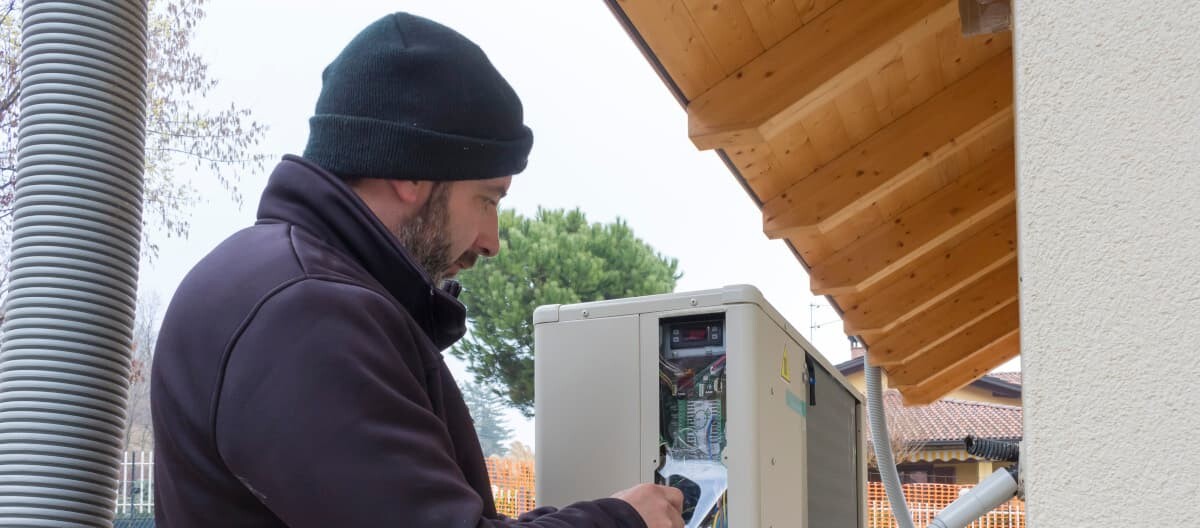So, how do heat pumps work?
Heat pumps are considered to be sustainable and efficient systems for generating heat in buildings. As they do not use fossil resources, rather they convert heat from the environment into usable energy with the help of electricity. Of course, the power consumption should be lower than the energy production. The higher the efficiency of a heat pump, the more efficient it works. The efficiency is defined by the so-called annual performance factor (JAZ). In reality, the general rule is: the higher the JAZ, the better because less electricity is consumed for the heating output.
Generally speaking, heat pumps work according to the following principle: Ambient heat reaches the compressor via a refrigerant liquid in a pipe system, which compresses the medium and transports it to the heat exchanger. There, the heat is transferred to the building's heating system. When the heat is released, the agent liquefies again and flows back into the evaporator via an expansion valve.
There are three types of heat pumps, which differ mainly in the heat source:
- Air-to-water heat pumps: The previous standard solution as it is the easiest and cheapest to install. The heat is taken from the ambient air.
- Brine-water heat pumps: Very efficient as the heat is taken from the ground. As a general rule, deep drilling is necessary.
- Water-to-water heat pumps: Another highly efficient solution as the heat comes from the groundwater. However, excavation work is necessary for the installation to open up two wells.
This type of energy generation is also relevant for companies. However, commercial heat pumps must generate significantly more power than single-family home models. For a 500 square meter area, a heat pump should provide a heating output of at least 60 kW. But especially when combined with photovoltaic systems, heating systems can also be completely operated renewably in large commercial areas.

Advantages and disadvantages of heat pumps
The advantages of heat pumps have already been mentioned, here is an overview again:
- In combination with a green electricity provider or a photovoltaic system, a heat pump can be used for carbon neutral heating.
- The consumption and operating costs are significantly lower than that of oil or gas heating.
- A heat pump can also provide cooling, saving costs on air conditioning.
- There are funding opportunities that subsidize the replacement of conventional heaters.
However, there are also some disadvantages to consider:
- If more heat is required in the building than the heat pump can currently deliver, a heating element that is operated by electricity tends to steps in and then imposes additional costs.
- If a building has insufficient insulation, a lot of heating energy is lost.
- Heat pumps are not yet suitable for very cold regions with low sub-zero temperatures.
- The purchase and installation price is comparatively high and has skyrocketed in recent years due to increased interest. The same applies to electricity prices.
For which companies are heat pumps suitable
In general, installing a heat pump is only worthwhile if the total savings in gas or oil are greater than the increased use of electricity generated by the use of the pump. And, of course, the output of a heat pump must be sufficient enough to heat larger commercial areas. There are specific large heat pumps for companies that work with up to 2,500 kW. In addition to the standard heat sources, these systems have an advantage that they often also use preheated exhaust air or waste water and can feed their heat into local and district heating networks.
Companies can also link several heat pumps together into a so-called cascade connection. The advantage: The output is adapted to the heating or cooling requirement; increasing profitability.
Cost evaluation of heat pumps
As of February 2023, household air-water heat pumps cost more than 20,000 euros, including installation. For geothermal and groundwater heat pumps, the total minimum costs add up to approximately 40,000 euros. Yet, a lot of money can be saved through state subsidies of up to 40 percent. Large industrial heat pumps are significantly more expensive with the total investment costs quickly reaching six figures, depending on the size.
